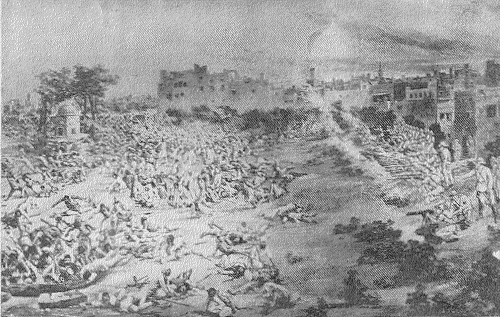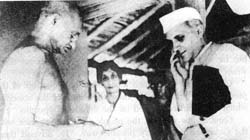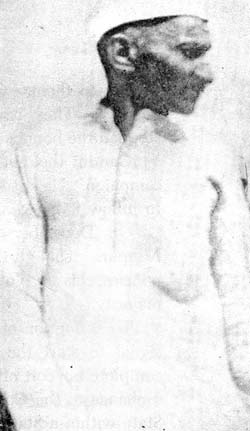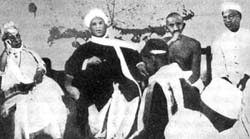

18. Jallianwala Bagh Massacre |
In the Punjab the situation was very critical. It was true that there were disturbances on the part of the people, but the measures adopted by the Government to check the disturbances were too severe. The leaders were trying to keep the people peaceful, but the stern measures of repression taken by the authorities had few parallels in history. In Amritsar the people were not allowed to move about freely. A proclamation was issued forbidding all gatherings and meetings. Only a few had the chance to know about the proclamation, however, because it was not announced widely, and it was made only in English. It was announced that a meeting was to be held in a garden called Jallianwala Bagh, to make a protest against the Government's actions. General Dyer took no measures to prevent the meeting. He reached the place soon after the meeting began and he took with him armoured cars and troops. Without giving any warning he ordered, 'Fire till the ammunition is exhausted.' The garden was surrounded by walls and buildings and had only one exit. At the first shot the exit was jammed and there was no hope of escape for the crowd. There were between six and ten thousand people there. The soldiers fired over sixteen hundred rounds into that unarmed mass of people. Once a garden, it was now a scene of merciless massacre. Hundreds of men, women, and children were butchered, though the official figures given were only 379 killed and 200 wounded. Leaving the wounded and dying on the ground, the troops marched away. The words 'Jallianwala Baugh became a synonym for massacre.  The Jallianwala Bagh massacre Bad as this was, there were other even more shameful deeds done all over the Punjab. Indians were ordered to crawl on their hands and knees. In addition General Dyer ordered that in certain areas all Indians were to alight from vehicles and salaam whenever they passed a British officer. Furthermore, at certain places men were stripped naked and flogged. Students and children to walk miles for roll call, to attend parades, and salute the British flag. Then there was the stripping and flogging of marriage parties, the censorship of communications, and cutting of water and electricity supplies to Indian families. The administration of General Dyer's martial law created a reign of terror in the Punjab. C.F. Andrews, who had already reached the Punjab, wrote to Gandhi and begged him to come at once. Gandhi wanted to go, but his repeated requests for permission to visit the place were turned down by the Government. Finally, in October that year, the Viceroy permitted him to visit the Punjab, and Gandhi went. On his arrival at Lahore railway station, Gandhi found that almost the entire population of the city was there waiting for him. The Congress had appointed a committee to enquire into the atrocities committed in the Punjab. On his arrival in Lahore he was requested to join the committee. He started a slow but methodical investigation of the incidents in the Punjab. Jawaharlal Nehru, who was also there in the Punjab, realized that Gandhi was the leader of the masses. People were drawn to him because of his thoughts and deeds. Nehru saw the scientific accuracy with which Gandhi was conducting the enquiry. Gandhi's report of the atrocities showed that efforts were being made by the government to shield certain persons. Gandhi was never interested in taking revenge on anybody but he was shocked at the way the Government sat silent when its own report was published. Gandhi was very much moved by the sufferings of the people in the Punjab. He knew the extent of the atrocities which had been committed on the defenseless people. Gandhi now advised the people to non-co-operate with the Government in every possible way. He advised them not to accept any of the honours offered by Britain, and requested those who had already received honours to return them. He wanted people to start a movement to boycott goods. He wanted every effort to be made to persuade Indians not to serve the Government in any capacity. He called out students from the educational institutions. Gandhi's influence on the Indian people was steadily growing. The old leaders, many of them with liberal policies, were vanishing from Indian politics. By the close of 1920 Gandhi was the undisputed leader and head of the Indian National Congress. The Congress was fighting for immediate Home Rule. Its method of fighting was non-violent non-co-operation with the Government, and defying carefully selected laws at suitable times. Gandhi was very interested in Jawaharlal Nehru and his socialistic views. He was most impressed with the account given by Jawaharlal of his contacts with the peasants. Jawaharlal explained the difficulties the peasants were experiencing, particularly the high taxes they had to pay. The political situation in India grew worse. The Government became nervous. There was tension everywhere and amidst the suppressed people there was the danger of violence.  With Nehru at Sevagram In spite of the hard attitude of the Government, Gandhi believed that England would soon right the wrong before it was too late. Jawaharlal was of the opinion that England would not change her policy unless she was forced to do so. Jawaharlal was right. Soon the Government started arresting the leaders and imprisoning them. The British were afraid to loosen their grip on India. On August 1, 1920, in a letter to Lord Chelmsford, the Viceroy, Gandhi gave the signal for a non-co-operation campaign. Along with it he returned the Kaiser-i-Hind gold medal which had been awarded to him in 1915. In the columns of Young India Gandhi wrote in detail in defence of non-violent non-co-operation. With other leaders he traveled extensively, addressing huge meetings and preaching the essentials of Satyagraha. Everywhere the crowds welcomed him with great love and enthusiasm. Again and again he warned the people against violence. He abhorred mass fury. 'If India has to get her freedom by violence', he said, 'let it be by the disciplined violence named war.' At the end of August the Gujarat Political Conference passed a non-co-operation resolution, and a special session of the Congress was held in Calcutta on September 4 to 9. The draft of the non-co-operation resolution had been prepared by Gandhi.  Wearing the 'Gandhi' cap Gandhi was not sure how much support he would get at the Congress session. When he moved the resolution he said that he knew the resolution envisaged a policy which was different from the policy hitherto followed. He knew that many leaders were dead against it. 'But,' he declared, 'knowing this I stand before you in fear of God and with a sense of duty to put this before you for your acceptance.' The special Congress session adopted the non-co-operation plan as a means of attaining Swaraj. During the latter part of 1920 Gandhi advocated a triple boycott. He wanted an absolute boycott of the Government and all government institutions, including schools, colleges, and courts. If the people were free of these they could easily have their own schools, colleges, and courts, and the power of the British would collapse at once. There was much laughter and ridicule from the moderates and the supporters of British rule. But Gandhi paid no attention to them. Gandhi's activities made the Government panicky. They issued a warning that anyone who overstepped the bounds of law would be arrested and imprisoned. Gandhi thought that this warning was a victory for the campaign. He issued instructions which the people were to follow if he were arrested. On December 26, the Congress session was held in Nagpur. Though there were signs of opposition to Gandhi's policies his resolution was passed with an overwhelming majority. The adoption of the new programme at Nagpur was the signal to start the mass movement. Gandhi felt that the complete boycott of all government organizations would give a chance to the Congress to set up a parallel organization, a State within a State which would lead India to Swaraj. The Duke of Connaught was sent to India in 1921 to try to pacify the Indians. He came to open the four legislatures in the country which had been introduced as a result of the reforms announced by the King. His coming and going passed off without any material change in the attitude of Indians towards Britain. Gandhi traveled far and wide, propagating the ideals of non-violence and non-co-operation. Day by day the Indians were getting more and more excited over carrying out Gandhi's programme. Many students left their institutions, many officers resigned their posts. The boycott movement gained momentum. As the people's morale grew, the morale of the Government went down. Repression started. Gandhi advised the people to have patience, and he insisted on non-violence. He saw the weakness of Indians and he urged them to improve. He wanted social reforms and constructive work to be intensively followed.  With Annie Besant, Shrinivas Shastri, and Satyamurthi It was announced were arranged the Prince of Wales was to visit India. Functions were arranged at many places to enable him to meet his loyal subjects. Gandhi was indignant when he read the announcement in the newspapers. 'Do the British think we are children?' he said. 'Do they believe that parades for the Prince will make us forget atrocities in the Punjab or the perpetual delay in granting us Home Rule?' On Gandhi's advice the Congress declared that all parades, receptions, and celebrations in honour of the Prince were to be strictly boycotted. 'We have no grudge against His Royal Highness the Prince of Wales,' said Gandhi, 'but our ideas are against him as a symbol of oppression. We can show the world that such non-co-operation is just the reverse of the European doctrine of the sword. Let us act in accordance with the holy prophets of old. Non-co-operation without violence is the battle of the brave.' Fearing that there would be disorder when His Royal Highness the Prince of Wales visited various places, the government began severe acts of suppression. Thousands of people were arrested. The Indians people were so agitated than in city after city bonfires burned and the bonfires were made with foreign cloth, especially British cloth. On November 17, 1921, the Prince of Wales landed in Bombay. Loyal stooges of Britain went to greet the royal visitor. Those who were observing non-violent non-cooperation did not molest them. However, passion suddenly blazed out. Religious and political hatreds fanned the flames. Riots started, many were killed, much property was destroyed. There was panic in the city. Gandhi was in Bombay, and he rushed to the scene of disorder to stop the rioting. Order was finally restored. 'Every man has the right to his religion and his own political opinion. Satyagraha will never succeed until man understands that,' Gandhi announced bitterly. In other cities the boycott of the Prince's visit was peaceful. As the unfortunate Prince of Wales visited city after city, he was greeted with empty streets. Not a shop was open. The people remained behind closed doors and drawn curtains. This infuriated the British and they called upon the Government of India to act. Motilal Nehru, Jawaharlal, and other leaders were arrested and sentenced to various terms of imprisonment. Yet the determined courage of the people did not abate. They were ready to suffer any penalty for the cause of Home Rule. Demands had been made to Gandhi that he should start a mass movement for the attainment of Swaraj. Gandhi decided to act. Preparations were made to start Satyagraha in Bardoli. But Gandhi had to stop the campaign suddenly because of what had happened in Bombay and other places. In Chauri Chaura, near Gorakhpur in U.P., some policemen fired on a crowd which was holding a demonstration against the Government. This annoyed the demonstrators to such an extent that they became very violent. They chased the police. The police took refuge in the city hall. The angry mob surrounded the hall and set it on fire. Some policemen were burned to death. Others, trying to escape, were killed by the furious mob outside. Gandhi was very upset. He thought that it was clear that the people were still not prepared for satyagraha. He stopped the intended satyagraha at Bardoli. His co-workers did not agree with him, but he was adamant. He wanted his followers to start constructive programmes. Many Indians were sorry for Gandhi's action. They thought that Swaraj was now within their reach and the movement should therefore continue. The Government was playing a waiting game. Instead o thanking Gandhi for stopping the mass movement, they arrested him on charges of sedition and sentenced him to six years' imprisonment. He was removed to Yeravda Central Jail in Poona. |